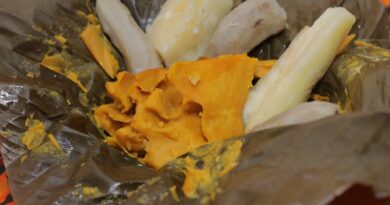Shakshouka
Shakshouka: A Culinary Symphony of Flavors and Heritage
Introduction:
In the world of culinary delights, few dishes can claim the title of both comforting and exotic quite like Shakshouka. Hailing from the vibrant landscapes of North Africa and embraced by the Middle East, this savory and aromatic dish has become a global sensation, captivating food enthusiasts with its bold flavors and cultural richness. Join us on a journey through the origins, preparation, and diverse variations of Shakshouka.
Origins and Cultural Roots:
Shakshouka’s roots are deeply embedded in the culinary traditions of North Africa, particularly in Tunisia and Morocco. The name “Shakshouka” is believed to have originated from the Arabic word “shakka,” meaning “to mix” or “to shake.” Over time, this dish migrated across borders, finding a place on the tables of countries like Israel, Palestine, and Lebanon.
The versatility of Shakshouka is a testament to the historical movement of people, trade, and culinary ideas in the region. Its journey across borders has resulted in various interpretations, with each locale adding its unique touch to this beloved dish.
Ingredients and Preparation:
At its core, Shakshouka consists of poached eggs in a rich and flavorful tomato and bell pepper sauce, typically seasoned with a blend of spices. While the basic elements remain consistent, the variations in spices and additional ingredients create a diverse tapestry of flavors. Here’s a breakdown of the key ingredients and a traditional preparation method:
Ingredients:
- Tomatoes: Fresh or canned, chopped or crushed – the tomatoes form the base of the sauce.
- Bell Peppers: Sliced or diced, adding sweetness and color to the dish.
- Onions: Finely chopped for a savory base.
- Garlic: Minced for aromatic depth.
- Eggs: Poached directly in the simmering sauce.
- Olive Oil: A staple in Mediterranean cuisine, providing richness.
- Spices: Common spices include cumin, paprika, cayenne pepper, and a pinch of cumin for warmth.
- Fresh Herbs: Parsley or cilantro for a burst of freshness.
- Feta Cheese: Optional, for added creaminess and tang.
Instructions:
- Sauté the aromatics: In a pan, heat olive oil and sauté finely chopped onions until translucent. Add minced garlic and cook until fragrant.
- Add bell peppers and spices: Stir in the sliced or diced bell peppers and add the selected spices, allowing the mixture to cook until the peppers soften.
- Tomato base: Introduce the tomatoes to the pan, allowing them to break down and create a thick, flavorful sauce. Simmer until the sauce thickens.
- Make wells for the eggs: Create small wells in the sauce and carefully crack the eggs into each well.
- Poach the eggs: Cover the pan and let the eggs poach in the simmering sauce until the whites are set but the yolks remain runny.
- Garnish and serve: Sprinkle fresh herbs and crumbled feta cheese on top. Serve the Shakshouka directly from the pan, family-style, with crusty bread for dipping.
Cultural Significance:
Shakshouka is more than just a dish – it is a representation of the diverse cultures and histories that converge in the Middle East and North Africa. It embodies the spirit of communal dining, with families and friends gathering around a shared pot to enjoy a meal together. The simplicity of Shakshouka, paired with its rich and comforting flavors, makes it a popular choice for breakfast, brunch, or even a hearty dinner.
In addition to its cultural significance as a communal dish, Shakshouka has become a symbol of the diverse culinary landscape of the Middle East and North Africa. As a vegetarian-friendly option, it caters to a wide range of dietary preferences, contributing to its popularity on a global scale.
Variations and Regional Twists:
While the basic components of Shakshouka remain consistent, the dish has evolved over time, adapting to regional preferences and ingredients. Here are some notable variations:
- Green Shakshouka: Substituting tomatoes with spinach, kale, or other leafy greens to create a vibrant and nutrient-packed variation.
- Harissa-infused Shakshouka: Adding a kick of heat with the inclusion of harissa, a North African chili paste.
- Seafood Shakshouka: Incorporating seafood such as shrimp or fish into the tomato sauce for a Mediterranean twist.
- Shakshouka with Merguez Sausage: Enhancing the dish with the bold flavors of North African Merguez sausage.
- Israeli Shakshouka: Often prepared with bell peppers and onions, and served with tahini on the side.
Health Considerations:
Shakshouka is not only a flavorful delight but also a relatively healthy option. The dish is rich in antioxidants from the tomatoes, bell peppers, and spices. The Eggs provide a good source of protein and essential nutrients, making it a satisfying and nutritious choice for any meal.
Conclusion:
Shakshouka stands as a testament to the culinary diversity and cultural richness of the Middle East and North Africa. Its journey from the streets of Tunis and Marrakech to the bustling kitchens of Tel Aviv and beyond has transformed it into a global sensation. Shakshouka is more than a dish; it is a celebration of shared meals, cultural exchange, and the universal love for flavorful, comforting food.
As you savor each bite of Shakshouka, let it transport you to the sun-kissed landscapes and bustling markets of its origin. Whether you enjoy it as a traditional family-style dish or with a modern twist, Shakshouka invites you to partake in the global symphony of flavors that transcends borders and connects us through the joy of shared meals.



